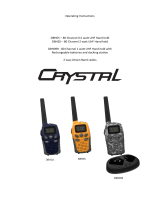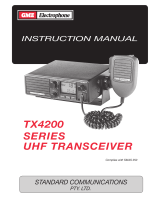2 INSTRUCTION MANUAL TX6500S
CONTENTS
ACCESSORIES SUPPLIED..................3
INTRODUCTION ........................3
IMPORTANT ADVICE.....................3
SAFETY INFORMATION...................3
IMPORTANT INFORMATION - UHF CB RADIO . . 3
FEATURES ............................4
LCD Icons.............................6
CONTROLS............................7
GETTING STARTED ......................8
GENERAL OPERATION ..................10
Power On/Off ......................10
Adjusting the Volume ................10
Display Lighting.....................10
Receiving Signals....................10
Signal Strength Meter ................11
Transmitting .......................11
Squelch ...........................12
Selecting Channels ..................12
Priority Channel.....................12
Time-out Timer .....................13
Silent Squelch Tail ...................13
Key Beeps .........................13
Voice Scrambler.....................13
Minimum Volume ...................14
Display Contrast ....................14
Dynamic Volume Control (DVC) .........14
Function Key .......................15
Keypad Lock .......................15
OS/GS Key.........................15
HI/LO Power .......................15
Duplex ...........................15
SCANNING ..........................16
Overview..........................16
Scan Groups .......................16
Open Scan.........................17
Group Scan ........................18
Auto Skip .........................19
Additional Open/Group Scan Options.....19
Network Scan (Net-Scan)..............20
Using the Priority Channel while Scanning . 22
SelCall ..............................22
SelCall Identification Number (IDENT) ....22
The Quiet Mode (Q)..................22
SelCall Memories....................22
Ident or Alpha Name .................23
Sending a SelCall....................23
Adding Alpha names to SelCall Idents ....24
Receiving SelCalls ...................25
Quiet Mode........................26
Scanning in the Quiet Mode............27
Group Calling ......................28
CTCSS & DCS.........................29
CTCSS Tone Set Compatibility ..........29
Monitor Function....................30
Busy Lockout.......................30
CTCSS TONE FREQUENCIES ..............31
DCS TONE CHART......................31
RECEIVE (RX) ONLY CHANNELS ...........32
Channel Editor .....................33
Signal Meter Display .................36
MENU FUNCTIONS.....................37
CONSERVING YOUR BATTERY POWER ......38
UHF CB OPERATING FREQUENCIES ........39
SPECIFICATIONS ......................40
STANDARD COMMUNICATIONS CONTRACT
WARRANTY AGAINST DEFECTS ...........42






















